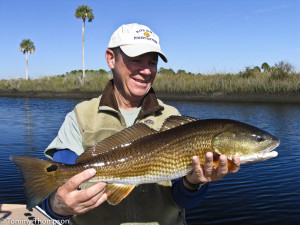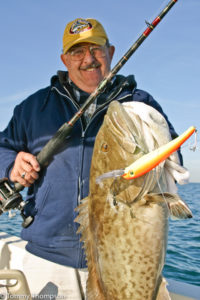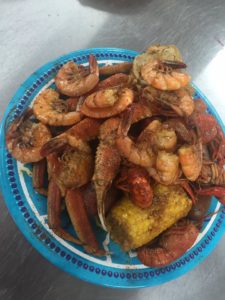Sizzlin’ Summertime Fishing at Cedar Key
The town of Cedar Key has two distinct personalities. One, it’s a fun place to visit, walk the streets, sight-see, shop in small galleries and eat at better-than-average restaurants. Second, and certainly more important to fishermen, it’s a great place to do some excellent inshore and offshore fishing, especially during the hot summer months when other Big Bend ports are preoccupied with recreational scalloping and scallopers.
The archipelago of Gulf islands known as the Cedar Keys sits twenty-plus miles from US 19/98, the major highway that parallels Florida’s Big Bend coastline. Even at the turn southwest on SR24 at Otter Creek, don’t expect much in the way of civilization—you’re in the middle of rural Levy County, and just about midway between Tampa and Tallahassee. And with the Cedar Keys no less isolated by water than by land, it’s their position, jutting far westward into the Gulf of Mexico, that makes them attractive to many fish species and the sportsman who follow them.
Summertime inshore fishing opportunities at Cedar Key range from seatrout fishing over lush grass flats to stalking redfish along island shorelines and oyster bars. Having a power boat will give you an advantage in terms of reaching many areas, but there’s excellent access for paddlers who find good fishing within easy reach of the public marina. There are also fishing piers, one in town and another on the Number Four Channel, available to shore-bound anglers.
The shallow flats near Snake Key are popular with anglers wishing to drift shallow grassy patches intersected by deeper sandy cuts. On falling tides, expect bait to wash from the shallows into these cuts and target the edges for seatrout, Spanish mackerel and even cruising cobia. This is a big area–use waypoint N29 04.313 W83 01.077 as a starting point. To the northeast of this area, in Waccasassa Bay, try the flats at about N29 06.081 W82 57.569. They’re a bit deeper where the water may be murky, but productive for many anglers. Finally, depending on prevailing winds, consider drifting any of the deeper flats offshore of North Key along Seahorse Reef to the Steel Tower (N28 58.515 W83 09.241), almost 10 miles south. On any of these flats you’ll have success fishing with live (shrimp, pinfish, white bait) or artificial baits (D.O.A. shrimp, CAL soft plastics, shallow-running MirrOlures).
You’ll find lots of the structure that attracts redfish near Cedar Key. To the east, there are the Corrigan Reefs (at approx. N29 09.170 W82 58.167) that function as barriers to the shoreline at the top of Waccasassa Bay. The fronts of these bars as well as their backwaters are easy to reach, but can be treacherous. However, it’s usually a trip well-worth the trouble for anglers wishing to toss topwater lures for happy and hungry redfish. Other options are the backwaters formed by channels between the islands making up the Cedar Keys. The Number Four channel is the most accessible, with a boat ramp near CR24 and decent (but shallow) access from both the Gulf and Bay sides. Here, target tailing reds with Eppinger Rex spoons (with red feathers) or fish for them in deeper cuts with live shrimp or cut bait. Be on the lookout for, and don’t be confused thinking they’re reds, big black drum along bars and shorelines. Not particularly good to eat, these whoppers often prefer dead rather than live shrimp, but are fun to catch and release. Redfish also cruise the shorelines of many of the Gulf-facing islands here. The bars along the south side of North Key, those around Deadmans Key (between North and Seahorse Key) and near the Gomez Keys (north of Marker #9 in the Northwest Channel at N29 08.955 W83 04.367) all have excellent ‘redfish potential’.
Near shore fishing opportunities here aren’t necessarily limited to shallow water. Cedar Key waters are fed by several deep channels that often bring action from sharks, sheepshead, tarpon, cobia and king mackerel surprisingly close to town. Don’t miss an opportunity to tangle with a summertime cobia by failing to stop at every channel marker you pass. Many successful cobia fishermen here simply idle past a marker with a live pinfish, crab, or artificial eel rigged on a big spinning outfit. If they see a ‘crab-eater’, it’s a matter of getting him interested. And even if you don’t see a cobia hovering, try putting your bait down deep around the base of the piling for five minutes or so. Tarpon also come surprisingly close to shore here on their journey northward from the spawning grounds near Chassahowitzka. Many stay for the summer, especially in the inner channels and along the channel that runs north from the Gulf entrance to the Number Four Channel towards the Suwannee River’s East Pass. In the summer months, silver kings feed deep, and it’s hard to beat a piece of cut mullet or ladyfish rigged on a circle hook for them (and a shark or two).
Cedar Key occupies a special place on the Big Bend coastline. Jutting well into the Gulf of Mexico, it provides anglers close access to deeper water and to many reef species. Three spots known to hold offshore fish on a regular basis in summertime are The Barge (30 miles out at N29 00.512 W83 31.623), White City Bridge (33 miles out at N29 10.000 W83 39.081) and the Gainesville Offshore Fishing Club Reef #3 (21 miles out at N29 06.841 W83 25.603). Any of these places can provide lots of action for offshore anglers, but boaters should always be careful to not get in the path of late-afternoon thunderstorms.
Marine facilities at Cedar Key are good, especially with Cedar Key Marina II under new ownership. Located on the backwaters, it offers boat storage, marine and fishing supplies. The best place for bait is Doug and Wendy Rains’ Bait & Tackle or the hardware store near the City Marina. Most visitors launch their boats at the in-town ramps or at the backwater ramp on the Number Four Channel. All are paved with adequate parking. Bigger boats use the downtown City Marina’s south-facing ‘outside ramp’ and smaller boats usually use the ‘inside ramp’, provided their height doesn’t prevent them from getting under the low bridge there. There is no ‘on-the-water’ fuel available at Cedar Key, so plan ahead. Gas is available for trailer boats at the Jiffy Store on SR24. Fishing kayaks are also available for rent from Kayak Cedar Keys (www.kayakcedarkeys.com).
Cedar Key offers a wide range of lodging and dining opportunities. The historic Island Hotel & Restaurant is a popular bed-and-breakfast owned by a local fishing enthusiast. If you want something more casual, try the angler-friendly Faraway Inn . Long term or weekend rentals are available from several condominium properties, including Old Fenimore Mill and Nature’s Landing . Good food can be had at a number of restaurants, but a bowl of the international award-winning clam chowder at Tony’s Seafood can be the highlight of your trip!
Afternoon sea breezes, good amenities and easy trips to good fishing areas make Cedar Key a ‘cool’ spot to visit in August while the rest of the region is either sweltering with heat or crowded with hordes of scallopers. Having no scallops to harvest can be a good thing, especially to hook-and-line anglers looking for some good action—and some peace and quiet!




